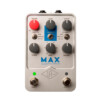Guitar Compressors
What does a guitar compressor do?
In this section you will find from inexpensive pedals for beginners to mid-range and to limited-production boutique-style pedals of the best quality on the market.
A guitar compressor is a pedal that keeps the volume variations that are generated when we strum or use a pick, generating a more constant and, therefore, defined signal. It is one of the most underrated pedals, but if you want to keep those volume variations at bay, generating a more constant signal and giving more body to your sound, it is absolutely necessary.
A compressor is nothing more than an electronic sound processor that reduces the dynamic range of the signal. That is, the difference between the weakest sound and the loudest.
Typically a compressor usually has the following parameters:
- Threshold: It is the parameter that indicates to the compressor from which signal level it is going to act, and is measured in decibels. The lower the threshold, the more of the signal will be processed.
- Ratio: Indicates the amount of signal reduction and is usually expressed as two numbers. For example, a 4: 1 ratio indicates the compressor that once the signal level exceeds the amount set in the threshold, the signal level is allowed to decrease 1 dB for every 4 dB of increase in signal.
- Attack: This is the time it takes for the compressor to compress the signal once it exceeds the threshold level and is measured in microseconds and miliseconds.
- Decay (Release): It is the time it takes for the compressor to stop compressing and is measured in microseconds and miliseconds.
- Gain: Increases or decreases the signal level. Normally is used to compensate for the level that is lost when compressing.
Where do I place the guitar compressor?
This will depend on several factors, but in a simple effects chain, it should normally be placed first, ideally right after the tuner. And this is so because when configuring our sound, it is very important to have a constant signal level, without unwanted peaks.
If what we want is to correct the dynamics (volume variations) that a certain effect on our chain provides (for example a treble booster), we can also place it behind that effect to keep peaks at bay or correct a certain problem.
You can also place it at the end of the chain with slight adjustments, just not to saturate the signal. As always, it is best to experiment in different positions.
